|
- Catalog (in stock)
- Back-Catalog
- Mail Order
- Online Order
- Sounds
- Instruments
- Projects
- History Face
- ten years 87-97
- Review Face
- our friends
- Albis Face
- Albis - Photos
- Albis Work
- Links
- Home
- Contact
- Profil YouTube
- Overton Network
P & C December 1998
- Face Music / Albi
- last update 03-2016
|
1. Uyakhan Zambuu tiviin naran - the sun give us warmth and energy - long song - 4:41
2. Dunshaa Göögöö - the name of a young man - short song - 1:33
3. Busgui khunii zaya - the karma of a young woman - short song – Uzemtsin tribe - 3:37
4. Ar khövchiin unaga - the foals from Ar Khuvts - long song - North Mongolia - 3:04
5. Tsagaan sar - the white moon - short song - 3:36
6. Taliin tavan tolgoi - the five heads of this little mountain range - besreg song - South-West of Mongolia - 2:23
7. Urikhan khongor salkhi - the soft warm wind - long song - 3:59
8. Tuuliin ursgal shönödöö saikhan - a beautiful night at the River Tuul - short song - 3:04
9. Shar taliin tsetseg - the flowers in the yellow steppe - long song - 3:00
10. Aduuchin - horseman - short song - 1:27
11. Argagui amrag - the real beloved - short song - 4:40
12. Kherlengiin bariya - the blue River Kherlen - long song - South East Mongolia - Borjigon tribe - 4:49
13. Junden Göögöö - the young handsome man - short song - 1:34
14. Algirmaa - name of a wife - short song - 3:33
15. Önchin tsagaan botgo - the young white motherless camel - besreg song - South Mongolia - 3:40
16. Buyankhishig Da lam - the name of a monk - short song - 2:38
17. Jiijuu khantaaz - the jacket with embroidery pattern - short song - 2:35
18. Dörvön tsagiin tal - the four seasons in the steppe - short song - 3:19
19. Khamgiin dundaas ontsgoi - couples live in harmony - short song - 1:27
20. Ulemjiin chanar - love song - besreg song - 4:55
21. Goviin öndör - the valley in the Gobi desert - Anduuchin - horseman - two short songs - 2:53
The ensemble was founded in 1997. All its members have studied at the academy of music in Ulaanbaatar.
The Mongolians conferred the title Khan (Khan = King) to their highest-ranking ruler (tribal chief) of the tribes. Undur Gegeen Zanabazar was the first Bogd (1635-1723), this high-ranking Buddhist monk ruled from Urga, the historic capital of Mongolia. He was a celebrated monk and statesman, and he was also Mongolia's greatest artist. Since Zanabazar, this highest-ranking representative of the Buddhists in the 17th century, the title Khan Bogd (King Bogd) has been established. Khans were simultaneously highest-ranking Buddhist as well as profane leaders. The last Mongolian Khan Bogd died in 1924. He was the last religious and profane ruler of the Mongols who resided in the Khan Bogd Palace. The place of residence was called Ulaanbaatar, i.e. 'Red Warriors' or 'Red Heroes'.
In the Mongolian language this designation is also used for important or holy mountains or even whole mountain ranges, such as the Tavan Bogd Mountain Range in the Northern Mongolian part Khuvsgul aimark, the Aj Bogd-Mountain in the Western Mongolian area of the Gobi-Altai province, or the Bogd Khan Mountain Range near Ulaanbaatar, the oldest Mongolian nature reserve (today it is a national park).
In the Ensemble Khan Bogd these lamaistic gods, the secular rulers and the mountains are being praised in songs (see Magtaal - Höömij - FM 50044 - Vol. II). Songs and texts are performed in throat singing (Höömij). In this first record 'Ayalguu' - FM 50043 - Vol. I there are performed short songs (bogin duu) and long songs (urtyin duu). The songs are about nature, man, animals (especially the horse) and the land of the Mongolian in general.
The Mongolian songs have a rich repertory. Music spread from home to home on the occasion of festivities and by way of teaching. The family or the clan meeting constituted a good chance to gather and sing together, the chance to learn from others, and to take home a new melody. In this way, the ancient patterns performed in various corners of Mongolia have been preserved by local masters for the whole nation. Some specific types are: labor songs (work songs); buuvei songs (lullaby); hunter's calls [to attract animals by imitating their call); various herder's calls, [to manage the herds by means of signalling (each animal has its own signal)]; uukhai or gulyingoon songs which are linked to seasonal events (arrival of spring, mare milk flows, horse race training, etc.); many other songs announcing birthdays, weddings, national holidays, winning a horse race or a wrestling competition, celebration of the elders, wool cutting, cashmere combing, arrival of harvest and many more songs for singing and dancing together.
The nomad shepherds in Mongolia, like other nomads from Central Asia, used to play string and wind instruments. The national music of Mongolia has had a rich background and a great tradition that goes back many centuries. Ensembles (orchesters) have performed at court or in the monasteries for lamaistic celebrations or in ritual ceremonies. Ensembles also play for daily rites in the ger (round tents). The morin khuur (horse-head violin or 'fiddle') (morin = horse; khuur = sound, rhyme, melody) is the most important traditional instrument for dance and to accompany songs. It is the national instrument.
People say that it is connected with a handsome man. It is also played when an ewe does not want to suckle its lamb. It is believed that the ewe, hearing this music, will feel better and accept its lamb.
There is a legend about the origin of this instrument. A Mongol missed his dead horse so much that he used its head, its bones and its hair to build an instrument on which he started to play the familiar noises of his beloved horse.
The history of this instrument is based on two other legends:
- A shepherd received as a gift from his beloved woman a magical horse that could fly. He used it at night to fly to meet his beloved. His jealous wife cut the horse's wings off, so that the horse fell from the sky and died. The grieving shepherd made a horse-head fiddle from his beloved horse.
- A boy named Sükhe (or Suho). After a wicked Lord (Pagan God) had slaughtered the boy's prized white horse, the horse's spirit came back to Sükhe in a dream and instructed him to make an instrument from the horse's body, so that the two could still be together and neither of them would have to be alone.
Songs
- Urtyin duu (long song)
melismatic and richly ornamented, with a slow tempo, long melodic lines, wide intervals and no fixed rhythm.
It is sung in verses, without a regular refrain and with a full voice in the highest register. The melody has a coat, which covers three octaves. This requires a strict observance of the breathing rules. The breathing is actually free, but the singer has to keep the strict rules of performance, making only the absolutely necessary breathing breaks without interrupting the melodic ornaments. The richer the voice is and the longer the singer can hold it, the more intensive is the attention paid by the audience and the more appreciated is this performance.
People usually practise these long songs while being alone in the open steppe and riding along slowly. The repertory is an expression of the liberty and the vastness of the Mongolian steppe and is used to accompany the rites of the seasonal cycles and the ceremonies of everyday life. Long songs are an integral part of the celebrations held in the round tents and they must be sung following the strict rules of performance.
|
There are three categories of long songs:
|
|
-The extended ones with uninterrupted flowing melodies, richly ornamented, containing long passages in falsetto.
|
|
-The usual ones are shorter, less ornamented, and without falsetto.
|
|
-The shortened ones have short verses, refrains and melodic courses full of leaps and bounds (Besreg song).
|
|
1. Uyakhan Zambuu tiviin naran - the sun give us warmth and energy - long song |
|
- Duuren Uuriintuya: female voice, Ganburged Bukhchuluun: morin khuur |
|
Our sun give us warmth, energy for the life on our earth and the nature. |
|
|
|
4. Ar khövchiin unaga - the foals from Ar Khuvts - long song - North Mongolia |
|
- Duuren Uuriintuya: female voice, Dorjnyam Shinetsog-Gyeni: morin khuur |
|
All foals from Ar Kuvts are very strong and good horses. They are little, but have a good charakter. They are the fastest horses.
|
|
|
|
7. Urikhan khongor salkhi - the soft warm wind - long song |
|
- Duuren Uuriintuya: female voice, Ganburged Bukhchuluun: morin khuur |
|
About the soft and warm wind in the nature. The Mongolian people like to spend their time in nature and like this kind of wind very much. |
|
|
|
9. Shar taliin tsetseg - the flowers in the yellow steppe - long song |
|
- Duuren Uuriintuya: female voice, Dorjnyam Shinetsog-Gyeni: morin khuur |
|
About the yellow steppe with its beautiful flowers. The people love to be outside to enjoy the beauty of nature. |
|
|
|
12. Kherlengiin bariya - the blue River Kherlen - long song – South East Mongolia - Borjigon tribe |
|
- Duuren Uuriintuya: female voice, Dorjnyam Shinetsog-Gyeni: morin khuur |
|
The River Kherlen is the biggest river in the region of South East of Mongolia. The people love this land and the blue river. It flows quietly through this region. It’s the homeland of Genghis Khan.
|
|
|
| - |
Besreg song - the shortened ones have short verses, refrains, and melodic courses full of leaps and bounds. |
|
|
|
6. Taliin tavan tolgoi - the five heads of this little mountain range - the shortened (besreg song) - South-West of Mongolia |
|
- Duuren Uuriintuya: female voice
|
|
About the nature in the steppe with this little mountain range with its five heads. The love of a young woman who is living in this homeland (a cattlewife). The plants grow well in this warm Gobi part.
She is waiting for her husband who has been called up by the army. At this time the army cannot tell her if her beloved will return home within five years or if he has to stay longer.
|
|
|
|
15. Önchin tsagaan botgo - the young white motherless camel - the shortened (besreg song) - South Mongolia |
|
- Duuren Uuriintuya: female voice, Ganburged Bukhchuluun: text
- Gereltsogt Jamba: limbe, |
|
A young white camel is alone (motherless) and it is cold. It is missing its mother much. The mother is with the king's caravan on a trekking. The young has to wait for its mother coming back. But the mother will never come back.
|
|
|
|
20. Ulemjiin chanar - love song – the shortened (besreg song) |
|
- Duuren Uuriintuya: female voice
- Gereltsogt Jamba: limbe
|
|
A song from Dogshin Khutsagt Dananravjaa, a great singer who lives in the Gobi desert.
- About the nice woman, her love and her beauty, about her spiritual life and mind.
|
- Bogin duu (short song)
strophic, syllabic, rhythmically tied, sung without ornaments.
Short songs are never sung at celebrations, since they are spontaneously improvised and rather satirical. They are often sung in the form of a dialogue and speak of certain friends and incidents, or they are lyrical tales about love, about everyday life and about animals, especially horses.
|
2. Dunshaa Göögöö - the name of a young man - short song |
|
- Duuren Uuriintuya: female voice
- Orkhonbaatar Chinbat: ever buree, Gereltsogt Jamba: limbe, Ganburged Bukhchuluun: morin khuur, Dorjnyam Shinetsog-Gyeni: morin khuur, Ganbaatar Enkhzaya: yoochin, Gankhuyag Uyanga: khuuchir, Gankhuyag Solongo: yatga
|
|
A young girl is missing her boyfriend 'Dunshaa Göögöö' very much and waits a long time for him to come back. When she is sleeping, she dreams about him and wishes that he would come back soon. |
|
|
|
3. Busgui khunii zaya - the karma of a young woman - short song - Uzemtsin tribe |
|
- Duuren Uuriintuya: female voice
- Ganburged Bukhchuluun: morin khuur, Dorjnyam Shinetsog-Gyeni: morin khuur, Ganbaatar Enkhzaya: yoochin |
|
About a young woman, her life and about her luck to be a good mother. |
|
|
|
5. Tsagaan sar - the white moon - short song |
|
- Duuren Uuriintuya: female voice
- Orkhonbaatar Chinbat: ever buree, Gereltsogt Jamba: limbe, Ganburged Bukhchuluun: morin khuur, Dorjnyam Shinetsog-Gyeni: morin khuur, Ganbaatar Enkhzaya: yoochin, Gankhuyag Uyanga: khuuchir, Gankhuyag Solongo: yatga
|
|
About the white moon and about love in this night of full moon. On the basis of the Mongolian lunar calendar, on the first day after full moon in winter there is celebrated the "Mongolian Greetings" (White Night), similar to our "New Year's Eve". |
|
|
|
8. Tuuliin ursgal shönödöö saikhan - a beautiful night at the River Tuul - short song |
|
- Duuren Uuriintuya: female voice
- Orkhonbaatar Chinbat: ever buree, Gereltsogt Jamba: limbe, Ganburged Bukhchuluun: morin khuur, Dorjnyam Shinetsog-Gyeni: morin khuur, Ganbaatar Enkhzaya: yoochin, Gankhuyag Uyanga: khuuchir, Gankhuyag Solongo: yatga
|
|
Couples of girls and boys spend the beautiful night at the banks of the River Tuul (the River Tuul is in Ulaanbaatar). They talk about love and nature. |
|
|
|
10. Aduuchin - horseman - short song |
|
- Duuren Uuriintuya: female voice
- Orkhonbaatar Chinbat: ever buree, Gereltsogt Jamba: limbe, Ganburged Bukhchuluun: morin khuur, Dorjnyam Shinetsog-Gyeni: morin khuur, Ganbaatar Enkhzaya: yoochin, Gankhuyag Uyanga: khuuchir, Gankhuyag Solongo: yatga
|
|
About a good horse and its horseman. They live together in lovely harmony
|
|
|
|
11. Argagui amrag - the real beloved - short song |
|
- Duuren Uuriintuya: female voice
- Ganbaatar Enkhzaya: yoochin, Gankhuyag Solongo: yatga
|
|
About legal love. In ancient times it was difficult for real lovers to get married. The parents decided whom they had to get married to.
In these times many real lovers did not have a chance to get married and share a legal life together. They had to meet in secrecy and nobody was to know anything about their real love. Today it's much different; life is like in Europe.
|
|
|
|
13. Junden Göögöö - the young handsome man - short song |
|
- Duuren Uuriintuya: female voice
- Orkhonbaatar Chinbat: ever buree, male voice, höömij, Gereltsogt Jamba: limbe, Ganburged Bukhchuluun: morin khuur, Dorjnyam Shinetsog-Gyeni: morin khuur, Ganbaatar Enkhzaya: yoochin, Gankhuyag Uyanga: khuuchir, Gankhuyag Solongo: yatga
|
|
This is the legend of a young and handsome man of the name of Junden Göögöö. He lived in the middle of the 19th century in the region of the River Khalkh (Dornod-Aimak). He was a dexterous wrestler and archer as well as a good singer. He wore his hair long like a woman and he had a dark skin. Up to date, whenever Mongolian girls talk about a young handsome man, they call him Junden Göögöö. |
|
|
|
14. Algirmaa - name of a wife - short song |
|
- Duuren Uuriintuya: female voice
- Orkhonbaatar Chinbat: ever buree, Gereltsogt Jamba: limbe |
|
After Algirmaa's husband had been called up for military service, his parents chased her from their house. Now she is waiting patiently for her husband's return. Finally he comes back and takes his wife home again. |
|
|
|
16. Buyankhishig Da lam - the name of a monk - short song |
|
- Duuren Uuriintuya: female voice
- Orkhonbaatar Chinbat: ever buree, Gereltsogt Jamba: limbe, Ganburged Bukhchuluun: morin khuur, Dorjnyam Shinetsog-Gyeni: morin khuur, Ganbaatar Enkhzaya: yoochin, Gankhuyag Uyanga: khuuchir, Gankhuyag Solongo: yatga
|
|
Buryankhishig is a good monk. The women like him. |
|
|
|
17. Jiijuu khantaaz - the jacket with embroidery pattern - short song |
|
- Duuren Uuriintuya: female voice |
|
Jiijuu - a kind of emproidery pattern. The boyfriend's jacket with these ornaments is very nice. The girl loves this jacket and sleeps with it. |
|
|
|
18. Dörvön tsagiin tal - the four seasons in the steppe - short song |
|
- Duuren Uuriintuya: female voice, Dorjnyam Shinetsog-Gyeni: male voice, höömij
- Orkhonbaatar Chinbat: ever buree, Gereltsogt Jamba: limbe, Ganburged Bukhchuluun: morin khuur, Ganbaatar Enkhzaya: yoochin, Gankhuyag Uyanga: khuuchir, Gankhuyag Solongo: yatga
|
|
Song about the four seasons in the steppe - spring, summer, autumn, and winter. The beautiful changes of color in nature. The flowers grow in spring. The young animals jump in the steppe etc. |
|
|
|
19. Khamgiin dundaas ontsgoi - couples live in harmony - short song |
|
- Duuren Uuriintuya: female voice
- Orkhonbaatar Chinbat: ever buree, Gereltsogt Jamba: limbe, Ganburged Bukhchuluun: morin khuur, Dorjnyam Shinetsog-Gyeni: morin khuur, Ganbaatar Enkhzaya: yoochin, Gankhuyag Uyanga: khuuchir, Gankhuyag Solongo: yatga
|
|
Couples who live together in a plain and modest way, who master hard everyday work and also share their life together. They live in harmony with themselves and with nature. |
|
|
|
21. Goviin öndör - the valley in the Gobi desert - Anduuchin - horseman - two short songs |
|
- Dorjnyam Shinetsog-Gyeni: male voice, "isgeree" - (a kind of whistle)
- Orkhonbaatar Chinbat: ever buree, male voice, höömij, Gereltsogt Jamba: limbe, male voice, höömij, Ganburged Bukhchuluun: morin khuur, male voice, höömij, Dorjnyam Shinetsog-Gyeni: morin khuur, male voice, höömij, Ganbaatar Enkhzaya: yoochin, horse-clap, Gankhuyag Uyanga: khuuchir, Gankhuyag Solongo: yatga
|
|
The first song describes the beautiful valley in the desert Gobi, whereas the second one is about a good horseman. The Mongols like to combine two songs. |
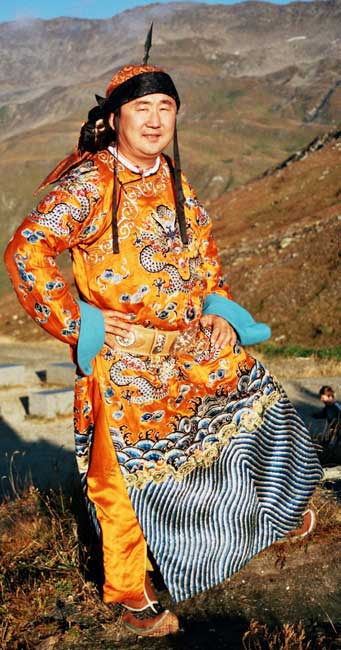
Gankhuyag Natsag
director
|
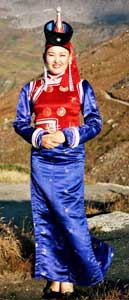
Duuren Uuriintuya
female voice
|
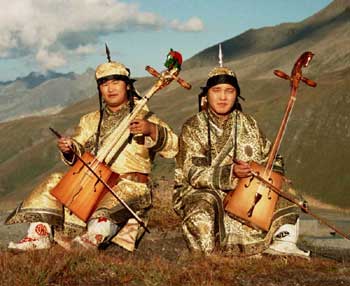
Dorjnyam Shinetsog-Gyeni and Ganburged Bukhchuluun
morin khuur
|
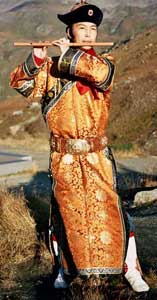
|
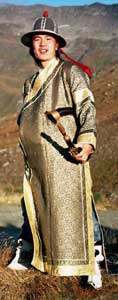
Orkhonbaatar Chinbat
ever buree
|
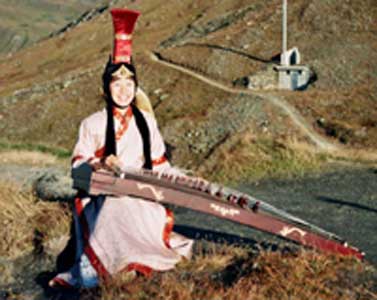
|
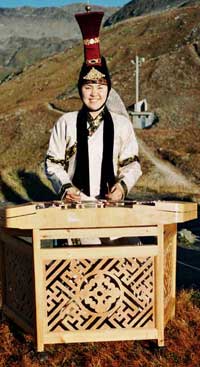
Ganbaatar Enkhzaya
yoochin
|
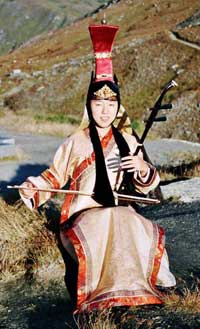
|
|
Instruments
- Limbe (wind instrument)
The instrument is frequently used in accompaniment, occasionally also as a solo instrument. In former times it was made of bamboo or wood, nowadays mostly of plastic, particularly those imported from China. These flutes (transverse flutes) are closely bound up with the nomads of Central Asia.
The length of this instrument is approx. 64 cm, with nine holes, whereof one is the blowhole and two others are reserved for the tuning. It is often played with circular breathing*. The sound reflects what is heard in the nature or the sounds of the natural and social environment.
- *Circular breathing (bituu amisgal): one note is blown while the musician inhales through his nose. The air is collected inside the cheeks and exhaled by the pressure of the cheeks' muscles (same principle as for the bagpipe). The base of the tongue is used as a valve.
- Surnai - ever buree (wind instrument)
Reed instrument - a folk oboe with a conical body made of wood or horn (ever buree = horn), widening towards the end. It has seven finger holes and one thumbhole. A metal staple carries the reed and a lip-disc in the shape of a funnel. The short form of the instrument is known as "haidi", meaning 'flute of the sea'.
- Khuuchir (string instrument)
Formerly, the nomads (called "the savages") mainly used the snake skin violin or horsetail violin. The Chinese call it "the Mongol instrument" or "Huk'in". It is tuned in the interval of a fifth and is small or middle sized.
The khuuchir has a small, cylindrical, square or cup-like resonator made of bamboo, wood or copper, covered with a snake skin and open at the bottom. The neck is inserted in the body of the instrument. It usually has four silk strings, of which the first and the third are accorded in unison, whereas the second and fourth are tuned in the upper fifth. The bow is coated with horsetail hair and inseparably interlaced with the string-pairs; in Chinese this is called "sihu", that is "four", also meaning, "having four ears". The smaller instruments have only two strings and are called "erh'hu", that is "two" in Chinese.
- Morin khuur (string instrument - horse-head-violin)
The morin khuur is a typical Mongolian two-stringed instrument. The body and the neck are carved from wood. The end of the neck has the form of a horse-head and the sound is similar to that of a violin or a cello. The strings are made of dried deer or mountain sheep sinews. It is played with a bow made of willow, stringed with horsetail hair and coated with larch or cedar wood resin.
This instrument is used to play polyphonic melodies, because with one stroke of the bow the melody and drone-strings can be played at the same time. The morin khuur is the most widespread instrument in Mongolia, and it is played during celebrations, rituals and many other occasions, as well as an accompaniment for dances or songs. Even the sound and noises of a horse herd are imitated on the morin khuur.
- Yoochin (string instrument)
Box zither - dulcimer with 13 double-wire strings. The strings are struck with two wooden sticks, so-called little wooden hammers (comparable with the santur of the Persians). It has a black wooden soundboard richly decorated with ornaments.
The instrument was only familiar to townspeople and first of all only they played it.
- Yatga (string instrument)
The yatga is a half-tube zither with a movable bridge. It is constructed as a box with a convex surface and an end bent towards the ground. The strings are plucked and the sound is very smooth. The instrument was considered to be sacrosanct and playing it was a rite, bound to taboos. The instrument was mainly used at court and in monasteries, since strings symbolised the twelve levels of the palace hierarchy.
Shepherds were forbidden to play the twelve-stringed zither, but they were allowed to play the ten-stringed zither, which was also used for interludes during recitations of epics.
Mongolians traditionally play three types of this zither, differentiated by their resonators or hollow bodies in which the sound is amplified. Designs include the master yatga; ikh gariing yatga, the national yatga; akhun ikh yatga, and the harp, called the bosoo yatga.
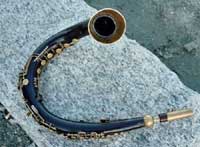 |
Surnai - ever burre = horn (wind instrument) |
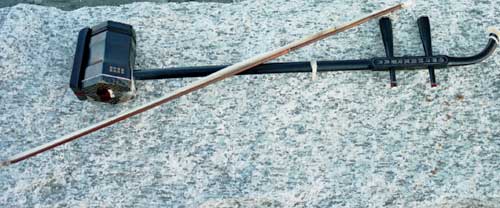 |
Khuuchir (string instrument) |
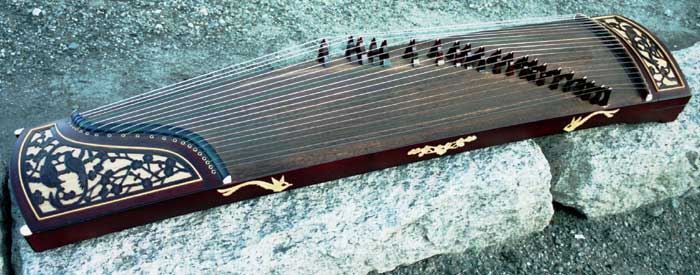 |
Yatga (string instrument)
- master yatga with 21 strings ( ikh gariing yatga) |
Revised by Hermelinde Steiner
PageTop

|
